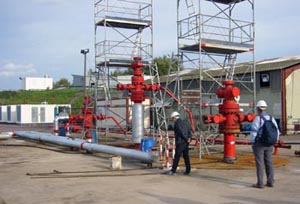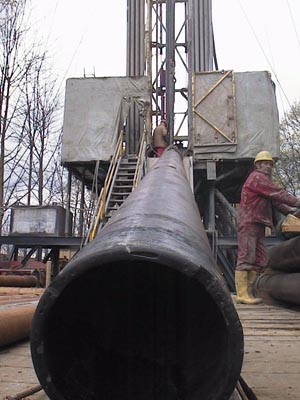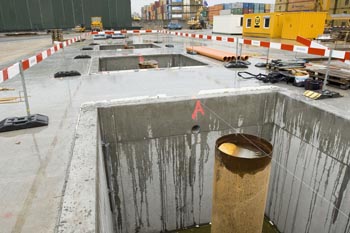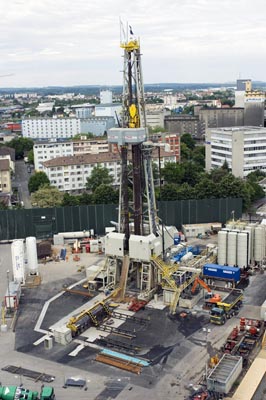- Start / Language
- HHO powered Powerplant
- HHO Systems in Cars
- Geothermal Energy
- Geotherm in Romania
- Partner and Links
- Sponsoring
Stimulated geothermal
systems
Current pilot projects
 European
Union project in Soultz sous Forêts, Alsace (France)
European
Union project in Soultz sous Forêts, Alsace (France)
The European EGS (SGS) project in Soultz sous Forêts (France) started 20 years ago. It acts today around the largest and furthest advanced geothermal project to the generation of electricity with warmth from deep depths. In the meantime three drillings to 5000 m depth exist, with which circulation tests were already accomplished. The drillings exhibit distances in the depth of 600 - 700 meters. With high pressure rock gaps were produced gradually. Also how the hydraulic connection between the drillings in the underground works, was examined.

The SGS technology reached an important milestone with this plant. The development of the SGS technology took place however gradually into larger depths. On this location, opened layer reservoir in 2000, to 3500 and 5000 meters under the earth's surface were provided. Only since 1998 the research work concentrates on the deepest range, where a reservoir could be produced of approx. 2,5 km3. Beginning of 2008 a small power station should be taken in Production.

Deep Heat Mining Project in Basle (Switzerland)
Basel is located of the southern end of the Rhine Valley, which represents a seam of the European continental plate. Here the earth's crust became thinner, whereby in small depth high temperatures can already be expected. In 5000 meters depth, 200 °C hot rock can already be found. The geological conditions are favorable. For a production plant however, the fact of an extensive long-distance heating net represents a central criteria for the use of the supplied warmth. 1998 began the work for a test drilling, which finally reached the crystalline basic rock in a depth of over 2.7 km. The measured temperature gradient corresponded to the expectations.
 In
order to supervise the creation of an underground heat exchanger with
under pressure opened Layers, listener drillings are necessary, into which
geophones (vibration sensors) are installed. These are registering the
signals of the opened layers and locate them. With these data it is
possible to create a three-dimensional map which serves as basis for the
placement of the further drillings. The six in Basle placed listener
drillings, placed in different depths, are used for these recordings.
In
order to supervise the creation of an underground heat exchanger with
under pressure opened Layers, listener drillings are necessary, into which
geophones (vibration sensors) are installed. These are registering the
signals of the opened layers and locate them. With these data it is
possible to create a three-dimensional map which serves as basis for the
placement of the further drillings. The six in Basle placed listener
drillings, placed in different depths, are used for these recordings.
The first production drilling of 5 km depth was realized between May and November 2006 in Kleinhüningen (suburb of Basle). Afterwards started immediately the stimulation of the opened layers. Unfortunately it came thereby to seismic events with Magnitudes higher than 3 on scale, which were realized by the population around it. Little damages were observed at some buildings. The canton of Basle has thereupon decided to let the project rest for the first and to make a study about seismic risks, before decission can be made wether the project can be continued or has to be stopped.

The electricity power plant at the surface, which should be taken 2009 in production, an electrical output of 6 MW and thermal output of 17 MW could be obtained and gives the possibility for a production of approximately 31 GWh of electricity and about 48 GWh of warmth per year. The choice between two possible modes of operation would offer a certain flexibility considering the customer needs: production could be co-ordinated either with the respective momentary heat consumption and the generation of electricity would be secondary, or vice-versa with regards on the momentary electricity consumption and the generation of heat would be secondary.
A first pilot plant of smaller size is necessary, in order to demonstrate the technical feasibility of such a project and than being basis for the development of similar systems.
.
.
.
.